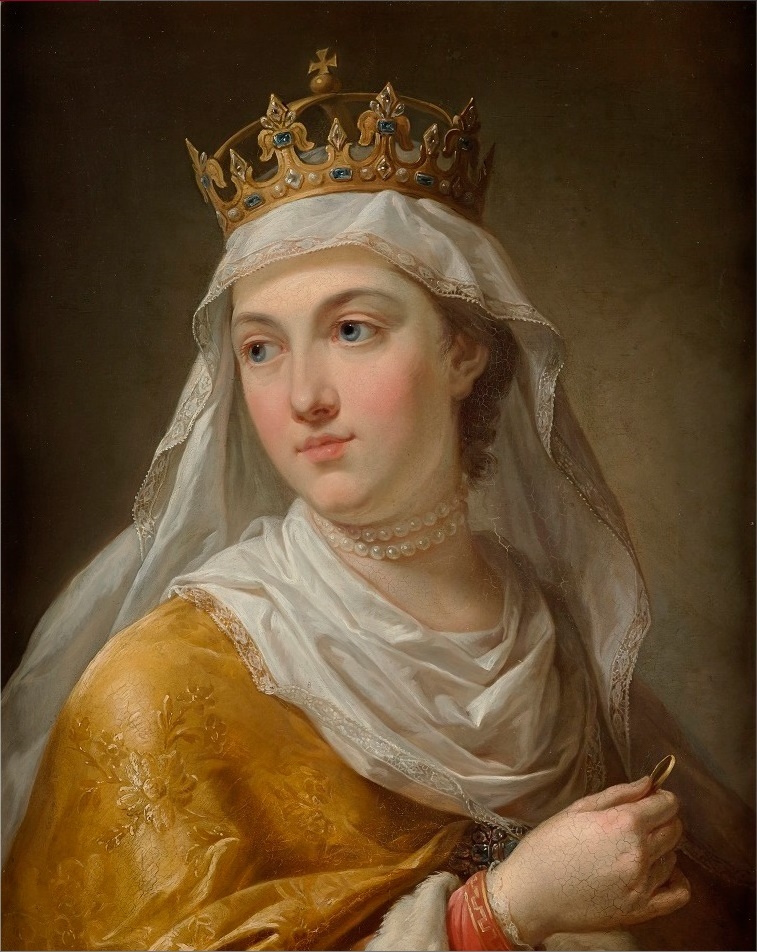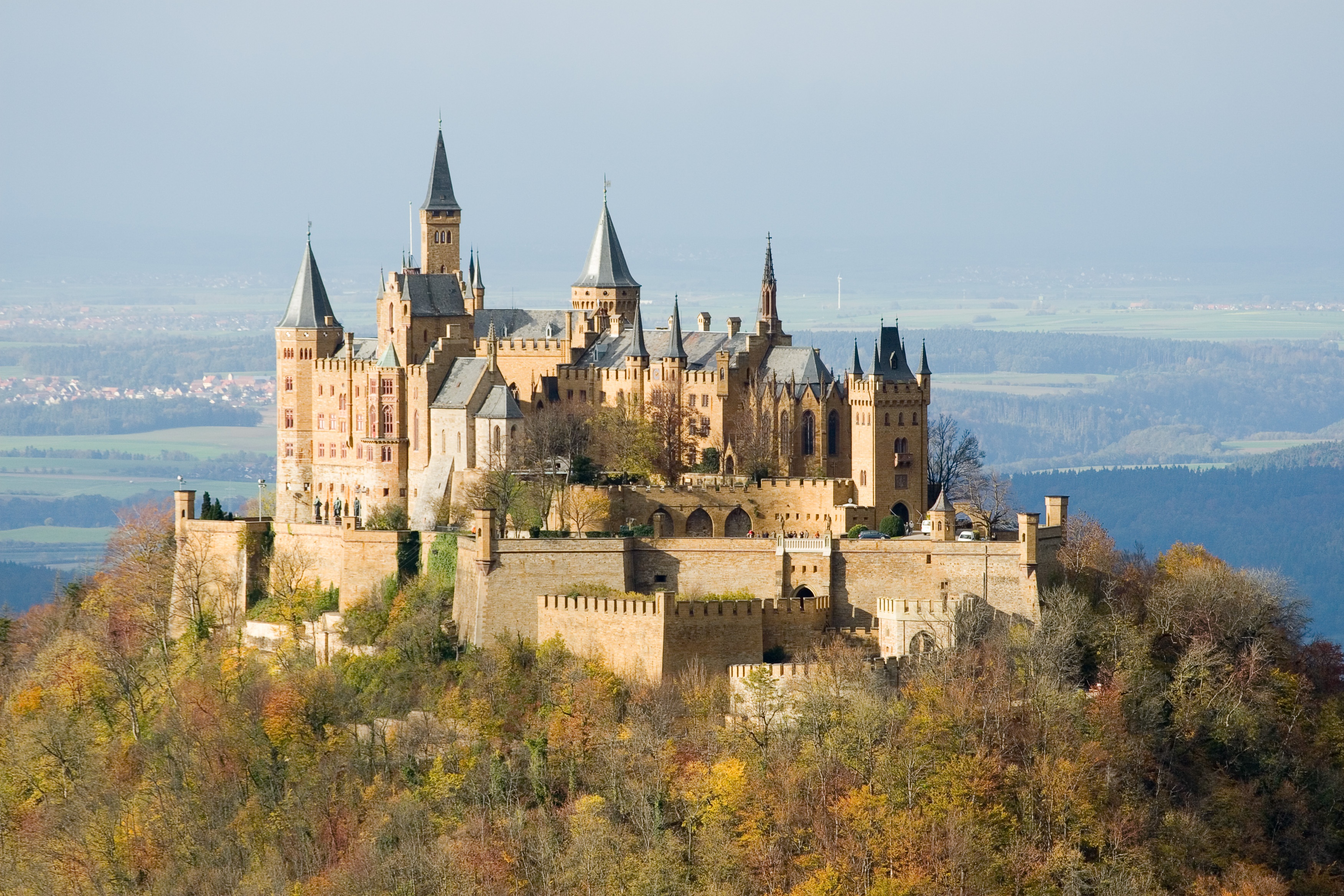|
Queens Crown
The Queen's Crown (Polish: "korona królowych" or "korona Jadwigi kaliskiej") was a part of the Polish Crown Jewels until it was destroyed in 1809. It was mentioned for the first time in the inventory of the Wawel Royal Treasury in the 15th century. History The Polish Queen's coronation insignia were originally made for Jadwiga of Kalisz, wife of Władysław I the Elbow-high in 1320, intended for her coronation as a Queen consort of Poland. Since that time it served as the main insignium of the Polish Queens till the end of the 17th century. The crown was stolen from the Wawel Castle by the Prussian troops in 1794 and found its place in the collections of the Hohenzollerns in Berlin. After 1809 it was destroyed and melted down just as the majority of Polish regalia. The Queen's Crown consisted of eight segments each crowned with heraldic fleur-de-lis and interspersed with smaller pinnacles. It was made of pure gold in the form of the rims covered with the globe and a cross ... [...More Info...] [...Related Items...] OR: [Wikipedia] [Google] [Baidu] |
Jadwiga By Bacciarelli
Jadwiga (; diminutives: Jadzia , Iga) is a Polish feminine given name. It originated from the old Germanic feminine given name Hedwig (variants of which include Hedwiga), which is compounded from ''hadu'' ("battle") and ''wig'' ("fight"). Jadwiga may refer to: * Jadwiga (wife of Władysław Odonic) (died 1249), Duchess consort of Greater Poland * Jadwiga of Kalisz (1266–1339), Queen of Poland and mother of Casimir III of Poland * Jadwiga of Żagań (before 1350–1390), Queen of Poland, wife of Casimir III of Poland (daughter-in-law of previous) * Jadwiga of Poland (1374–1399), female monarch of Poland, named after Saint Hedwig of Andechs * Jadwiga Lenartowicz-Rylko (1910–2010), Polish Catholic physician imprisoned in Ravensbruck. * Jadwiga Dzido (1918–1985), Polish survivor of Ravensbrück concentration camp * Jadwiga Jagiellon (other), several Polish princesses of that name * Jadwiga Rappé (1952–2025), Polish operatic contralto See also * Hedwig (disa ... [...More Info...] [...Related Items...] OR: [Wikipedia] [Google] [Baidu] |
Crown Of Bolesław I The Brave
A crown is a traditional form of head adornment, or hat, worn by monarchs as a symbol of their power and dignity. A crown is often, by extension, a symbol of the monarch's government or items endorsed by it. The word itself is used, particularly in Commonwealth countries, as an abstract name for the monarchy itself (and, by extension, the state of which said monarch is head) as distinct from the individual who inhabits it (that is, ''The Crown''). A specific type of crown (or coronet for lower ranks of peerage) is employed in heraldry under strict rules. Indeed, some monarchies never had a physical crown, just a heraldic representation, as in the constitutional kingdom of Belgium. Variations * Costume headgear imitating a monarch's crown is also called a crown hat. Such costume crowns may be worn by actors portraying a monarch, people at costume parties, or ritual "monarchs" such as the king of a Carnival krewe, or the person who found the trinket in a king cake. * The nu ... [...More Info...] [...Related Items...] OR: [Wikipedia] [Google] [Baidu] |
Individual Crowns
An individual is one that exists as a distinct entity. Individuality (or self-hood) is the state or quality of living as an individual; particularly (in the case of humans) as a person unique from other people and possessing one's own Maslow's hierarchy of needs, needs or goals, rights and moral responsibility, responsibilities. The concept of an individual features in many fields, including biology, law, and philosophy. Every individual contributes significantly to the growth of a civilization. Society is a multifaceted concept that is shaped and influenced by a wide range of different things, including human behaviors, attitudes, and ideas. The culture, morals, and beliefs of others as well as the general direction and trajectory of the society can all be influenced and shaped by an individual's activities. Etymology From the 15th century and earlier (and also today within the fields of statistics and metaphysics) ''individual'' meant "divisible, indivisible", typically des ... [...More Info...] [...Related Items...] OR: [Wikipedia] [Google] [Baidu] |
Royal Castle, Warsaw
The Royal Castle in Warsaw ( ) is a state museum and a List of Historic Monuments (Poland), national historical monument, which formerly served as the official Castle, royal residence of several List of Polish rulers, Polish monarchs. The personal offices of the king and the administrative offices of the royal court were located in the Castle from the 16th century until the final Partitions of Poland, partition of Poland in 1795. Situated in the Castle Square, Warsaw, Castle Square, at the entrance to the Old Town, Warsaw, Old Town, the Royal Castle holds a significant collection of Polish and European art. The Royal Castle witnessed many notable events in Poland's history; the Constitution of 3 May 1791, first of its type in Europe and the world's second-oldest codified national constitution, was drafted here by the Great Sejm, Four-Year Parliament. The edifice was redesigned into a Neoclassical architecture, neoclassical style following the partitions of Poland. Under the Secon ... [...More Info...] [...Related Items...] OR: [Wikipedia] [Google] [Baidu] |
Marcello Bacciarelli
Marcello Bacciarelli (; 16 February 1731 – 5 January 1818) was an Italian-born painter of the late-baroque and Neoclassicism, Neoclassic periods active in Poland and the Polish–Lithuanian Commonwealth. Biography He was born in Rome, and studied there under Marco Benefial. In 1750, with the recommendation of the architect Gaetano Chiaveri, Marcello was recruited to Dresden in Saxony, where he was employed by Elected King Augustus III of Poland. After the death of King Augustus, Marcello went to Vienna, and thence to Warsaw. In Dresden, he met Bernardo Bellotto and worked with this Italian painter throughout his life. He was recruited by King Stanisław II Augustus in 1766 to become the Director of the newly founded Royal Buildings and Estates. In Dresden, he married Johanna Juliana Friederike Bacciarelli, Friederike Richter, a woman painter known for miniature portraits. In Vienna, Marcello painted portraits of the imperial family, including the four daughters of Maria Teresa, ... [...More Info...] [...Related Items...] OR: [Wikipedia] [Google] [Baidu] |
Jadwiga Of Poland
Jadwiga (; 1373 or 137417 July 1399), also known as Hedwig (from German) and in , was the first woman to be crowned as monarch of the Kingdom of Poland. She reigned from 16 October 1384 until her death. Born in Buda, she was the youngest daughter of Louis I of Hungary and Poland, and his wife, Elizabeth of Bosnia. Jadwiga was a member of the Capetian House of Anjou, but she had more close forebears among the Polish Piasts than among the mostly French Angevins. In 1375, it was planned that when becoming old enough, Jadwiga would marry William of Austria and she lived in Vienna from 1378 to 1380. Louis I is often thought to have regarded her and William as his favoured successors in Hungary after the 1378 death of her eldest sister, Catherine of Hungary (1370–1378), Catherine, since the following year the Polish nobility had pledged their homage to Louis' second daughter, Mary, Queen of Hungary, Mary, and Mary's fiancé, Sigismund of Luxembourg. However, Louis died, and in 138 ... [...More Info...] [...Related Items...] OR: [Wikipedia] [Google] [Baidu] |
King Of Poland
Poland was ruled at various times either by dukes and princes (10th to 14th centuries) or by kings (11th to 18th centuries). During the latter period, a tradition of Royal elections in Poland, free election of monarchs made it a uniquely electable position in Europe (16th to 18th centuries). The first Polish ruler whose existence is not debatable was Mieszko I, Duke Mieszko I, who Christianization of Poland, adopted Christianity under the authority of Rome in the year 966. He was succeeded by his son, Bolesław I the Brave, who greatly expanded the boundaries of the Polish state and ruled as the first king in 1025. The following centuries gave rise to the mighty Piast dynasty, consisting of both kings such as Mieszko II Lambert, Przemysł II or Władysław I the Elbow-high and dukes like Bolesław III Wrymouth. The dynasty's rule over Poland ceased with the death of Casimir III the Great in 1370. In the same year, the Capetian House of Anjou became the ruling house with Louis I t ... [...More Info...] [...Related Items...] OR: [Wikipedia] [Google] [Baidu] |
Gold
Gold is a chemical element; it has chemical symbol Au (from Latin ) and atomic number 79. In its pure form, it is a brightness, bright, slightly orange-yellow, dense, soft, malleable, and ductile metal. Chemically, gold is a transition metal, a group 11 element, and one of the noble metals. It is one of the least reactivity (chemistry), reactive chemical elements, being the second-lowest in the reactivity series. It is solid under standard temperature and pressure, standard conditions. Gold often occurs in free elemental (native state (metallurgy), native state), as gold nugget, nuggets or grains, in rock (geology), rocks, vein (geology), veins, and alluvial deposits. It occurs in a solid solution series with the native element silver (as in electrum), naturally alloyed with other metals like copper and palladium, and mineral inclusions such as within pyrite. Less commonly, it occurs in minerals as gold compounds, often with tellurium (gold tellurides). Gold is resistant to ... [...More Info...] [...Related Items...] OR: [Wikipedia] [Google] [Baidu] |
Fleur-de-lis
The ''fleur-de-lis'', also spelled ''fleur-de-lys'' (plural ''fleurs-de-lis'' or ''fleurs-de-lys''), is a common heraldic charge in the (stylized) shape of a lily (in French, and mean and respectively). Most notably, the ''fleur-de-lis'' is depicted on the flag of Quebec and on the traditional coat of arms of France that was used from the High Middle Ages until the French Revolution in 1792, and then again in brief periods in the 19th century. This design still represents France and the House of Bourbon in the form of Heraldry#Marshalling, marshalling in the arms of Coat of arms of Spain, Spain, Coat of arms of Quebec, Quebec, and Coat of arms of Canada, Canada — for example. Other European nations have also employed the symbol. The ''fleur-de-lis'' became "at one and the same time, religious, political, dynastic, artistic, emblematic, and symbolic", especially in French heraldry. The Mary, mother of Jesus, Virgin Mary and Saint Joseph are among saints often depicted wit ... [...More Info...] [...Related Items...] OR: [Wikipedia] [Google] [Baidu] |
House Of Hohenzollern
The House of Hohenzollern (, ; , ; ) is a formerly royal (and from 1871 to 1918, imperial) German dynasty whose members were variously princes, Prince-elector, electors, kings and emperors of Hohenzollern Castle, Hohenzollern, Margraviate of Brandenburg, Brandenburg, Prussia, the German Empire, and Kingdom of Romania, Romania. The family came from the area around the town of Hechingen in Swabia during the late 11th century and took their name from Hohenzollern Castle. The first ancestors of the Hohenzollerns were mentioned in 1061. The Hohenzollern family split into two branches, the Catholic Church, Catholic Swabian branch and the Protestantism, Protestant Burgraviate of Nuremberg#List of burgraves, Franconian branch,''Genealogisches Handbuch des Adels, Fürstliche Häuser'' XIX. "Haus Hohenzollern". C.A. Starke Verlag, 2011, pp. 30–33. . which ruled the Burgraviate of Nuremberg and later became the Brandenburg-Prussian branch. The Swabian branch ruled the principalities of Hoh ... [...More Info...] [...Related Items...] OR: [Wikipedia] [Google] [Baidu] |







